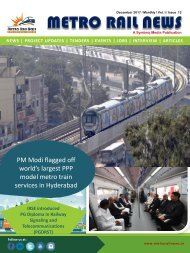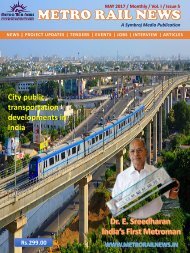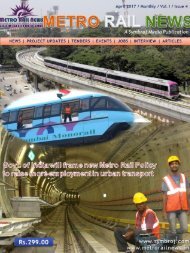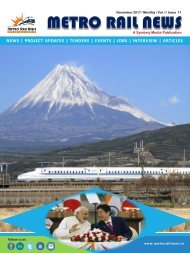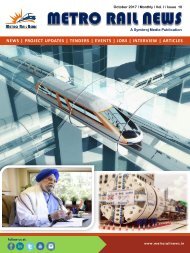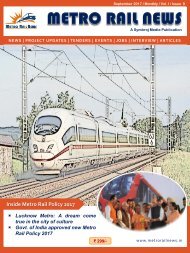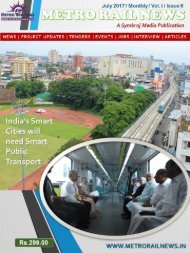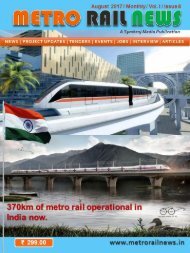Metro Rail News December 2016
Create successful ePaper yourself
Turn your PDF publications into a flip-book with our unique Google optimized e-Paper software.
planning. For the successful<br />
completion and implementation<br />
of such projects huge<br />
capital investments, long<br />
gestation period and complex<br />
technology is the need of hour.<br />
Research shows that the ideal<br />
share of public transport<br />
should be around 70% in<br />
India's metro cities, which at<br />
present is only around 35%–<br />
40%. India is looking to create a<br />
world class infrastructure with<br />
its existent Kolkata and Delhi<br />
<strong>Metro</strong>s.<br />
In addition we do have the<br />
<strong>Metro</strong> presence in Mumbai,<br />
Bengaluru, Hyderabad,<br />
Chennai, Jaipur, Gurgaon and<br />
Kochi. Additionally, the<br />
proposals for MRTS are being<br />
chalked out for Pune,<br />
Chandigarh, Ahmedabad,<br />
Kanpur, Ludhiana, Bhopal,<br />
Indore and Faridabad, which<br />
may be implemented in the<br />
next few years.<br />
Key Considerations<br />
MRTS projects are extremely<br />
large projects. The key<br />
attributes for this are finance,<br />
logistics, extensive data, study<br />
of economic structures,<br />
profiling topography, travel<br />
routes, major traffic corridors,<br />
detailed surveys etc. Another<br />
very important aspect is to<br />
learn from its previous<br />
limitations and imperfections.<br />
We can bring down our<br />
operation and maintenance<br />
costs by further developing of<br />
our in-house technology. This<br />
would be a large milestone in<br />
order to make such projects<br />
self-sufficient.<br />
Cost Factor<br />
At present <strong>Metro</strong> projects are<br />
catering to cities with<br />
population of more than four<br />
million people. The costs are<br />
directly proportional to the<br />
areas which are proposed to<br />
serve underground, elevated or<br />
at grade alignment projects.<br />
The high cost of metros is<br />
justified by its very high<br />
carrying capacity of passengers<br />
at a very high speed and with<br />
minimum pollution.<br />
Initially the funding of these<br />
projects was done through<br />
Public-Private Partnership<br />
(PPP) funding Model, Delhi<br />
<strong>Metro</strong> model or State / Central<br />
Government funding. The<br />
concept of Liberalisation,<br />
Privatisation and Globalisation<br />
(called the LPG model)<br />
introduced lately seems to be<br />
the most viable option to carry<br />
out such large projects across<br />
the country. Under this model<br />
the private sector developers<br />
are encouraged through<br />
viability gap funding scheme<br />
wherein 60% of the cost is<br />
ARTICLES |<br />
borne by private investor and<br />
40% is borne by the<br />
government in terms of grants.<br />
<strong>Metro</strong>s are known to serve the<br />
all sections of society at an<br />
affordable cost. Due to the<br />
huge capital costs involved in<br />
the implementation of MRTS it<br />
is suggested that government<br />
could participate through<br />
equity or meeting one time<br />
viability gap financing after<br />
detailed evaluation. For<br />
funding metros the<br />
government should provide<br />
infrastructure and the<br />
operating cost and cost of<br />
rolling stock must be met by<br />
users and beneficiaries. Where<br />
private players of repute are<br />
involved, the project could be<br />
sealed with private<br />
participation based on detailed<br />
conditions and period of<br />
concession specified. Land will<br />
be a major issue in realising the<br />
project for which the<br />
involvement of parastatal<br />
agencies will be critical. Sale of<br />
air space, advertisement rights,<br />
contribution of major<br />
commercial whole sale markets<br />
which generate huge volume of<br />
traffic, levying of external<br />
development charges on<br />
builders and promoters and a<br />
dedicated fund for MRTS can<br />
aid in the funding.<br />
<strong>Metro</strong> <strong>Rail</strong> <strong>News</strong> | <strong>December</strong> <strong>2016</strong> | www.metrorailnews.in 35






